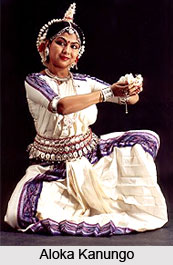 Aloka Kanungo has been a worthy personage to the art of Guru Kelucharan Mahapatra. In the Odissi genre, Aloka Kanungo is an illustrious name. She is empowered with a well-balanced body, fluent face, communicative eyes and natural beauty in body movement. Her body is conditioned into lithesome and flexible.
Aloka Kanungo has been a worthy personage to the art of Guru Kelucharan Mahapatra. In the Odissi genre, Aloka Kanungo is an illustrious name. She is empowered with a well-balanced body, fluent face, communicative eyes and natural beauty in body movement. Her body is conditioned into lithesome and flexible.
Aloka Kanungo with her elegant & dignified style easily captures the concentration of audience. She always tires to give expressions to her innovative creative ideas through the language of dance. Her ideas have been reflected in her much-appreciated productions, in which she experiments with Bandha and Stapatya satya.
At a tender age, Aloka Kanungo proved herself as a child prodigy. At that very young age, her quality as a born dancer and a versatile artist at the All India Radio, Cuttack exemplifies this notion. At the All India Radio, Cuttack, she was the newest actress and she has played the central roles in plays like "Matira Phoola", "Bissa Piyusa" and "Dukhi". As time goes on, she became a popular household name in Orissa. Aloka Kanungo was just six and half years old, when she was given felicitation by Kalindi Charana Panigrahi, the renowned poet, (father of Mrs. Nandini Satpathi, ex - chief minister of Orissa). The felicitation was given to her for her memorable performance at Janata Ranga Mancha, Cuttack. She has also acted in Oriya film namely "Matira Manisa", directed by Mr. Mrinal Sen.
Though Aloka Kanungo as a promising actress was beginning to become quite a household name, but she preferred to be a dancer. Guru Raghunatha Dutta and Guru Mayadhar Rout initially trained her. Under the tutelage and insomniac eyes of Guru Kelucharan Mahapatra, she blossomed out into a fine dancer. Kala Vikash Kendra, Cuttack honored her with the accolades "Nritya Shree", "Nritya Visharad" and "Nritya Praveen". In addition to the Shiromoni Puroshkar and the Mahari Award, she has received many esteemed awards throughout her professional career in Dancing. Probably she has carried out her dance performances all over the world. The talent of this dancer has been applauded by the entire world. Today she is reckoned as one of the world-beating classical dancers of India. She has also served as the member of the Film Censor Board (Eastern Zone) and as a dance critic for a national daily. She has also been the member of dance audition committee, Doordarshan Kendra Calcutta.



















